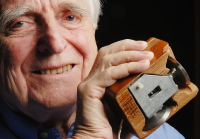One of the pioneers of the computer hardware and software
In 1968 he showed his Augment system,which were:
- Mouse
- Video display editing- movie making
- Mixed text and graphics, windowing
- Outlining
- Shared-screen video conferencing
- Computer conferencing
- Groupware
- Hypermedia
The Wordsmith's Toolbox
Working with a word processor involves several steps:
- Entering Text
- Editing Text
- Formattting the document
- Proofreading the document
- Saving the document on a disk
- Printing the document
Entering, Editing, and Formatting Text
- Entering Text
- Text is displayed onthe screen and stored in the computer's RAM
- Save your work periodically because RAM is not permanent memory
Editing Text - Navigate to different parts of document
- Insert or delete text at any point
- Move and copy text
- Search and replace words or phrases
- Word Processors and Other word tools
Formatting commands
- Formatting characters
- Characters are measured by the point size
- A font is a size and style typeface
- Serif fonts have serifs of fine lines at the ends of character
- You can use monospaced fonts of spaced fonts
Formatting paragraphs involve: - Margin settings
- Line spacing
- Indents
- Tabs
- Justification
Formatting the documents
- style sheets
- headers and footers
- multiple variable width columns
- graphics
- automatic editing features
- hidden comments
- table of contents and indexes
- coaching and helping feautures
- conversion to HTML
Rules of Thumb: Word Processing Is Not Typing - Use the return key only when you must
- Word wrap moves text to the next line
- Use tabs and margin guides, not the spacebar, to align columns
- WYSIWYG is a matter of degree
- Text that looks perfectly aligned onscreen may not line up on paper.
- Don't underline
- Use Italics and boldface for emphasis
- Use only one space after a period.
- Proportionally-spaced fonts look better without double space
- Take advantage of special characters
- bullets, dashes, curly or smart quotes
Outliners and Idea Processors are effective at:
- Arranging info into levels
- Rearranging ideas and levels
- Hiding and revealing of detail as needed.
Digital References
- Dictionaries, quotation books, atlases...
- The biggest advantage of the electronic form of speed.
- The biggest drawback is that
Synonym Finders
- A computerized thesarus that gives a variety of synonyms for a chosen
Spelling Checkers
- Compare words in your document with words in a disk-based dictionary.F7
Grammar and Style Checkers
- Analyze each word in context, checking for errors of content
- Check spelling
- Analyze prose complexity using measurements such as sentence length.
- Mail merge capabilities produce personalized form letters.
- Create a datatbase with names
- Create a form letter
- Merge the database with the form letter to create personalized letter.
- Example: give info and email and your name comes up so that it's as if Muhammad Shareef is emailing you personally.
- You can incorporate custom paragraphs based n the recipient's personal data.
- Each letter looks ad of it were individually written.
Collaborative Writing Tools
- Groupware: software designed to be used by a workgroup
- Provides for collaborative writing and editing
- Example: Google documents
- Compares documents versions and highlights differences in documents
- Processing handwritten words
- Processing words with software that can reliably recognize human speech
- Anticipating a writer's needs, acting as a an electronic editor.
The Desktop Publishing Story
- The process of producing a book, magazine, or other publication includes several steps:
- Writing text
- Editing text
- Producing drawings, photos, and other grahics to accompany the text.
- Designing a basic format for the publication
- Typesetting text
- Arranging text and graphics on pages
- Typesetting and printing pages
- Binding pages into a finished publication
- With modern desktop publishing tech (DTP), the production process can be accomplished with sophisticated tools
Desktop publishing software:
Image-editing software
Page layout software combines ht evarious source docs into a coherent, visually appealing publication.
QuarkXpress
PageMaker
Adobe InDesign
Rules of Thumb:
Plan before you publlish
Use appropriate fonts.
Don;t go style crazy
View your document through your reader's eyes
Learn from the masters
Formulas can be:
Relative
Linking spreadsheets together
Financial management software: Quickbook - gives reliability
Mathematica
Statistical Software: Beyond Spreadsheets
Scientific Visualization
Scientific visualization software shape
